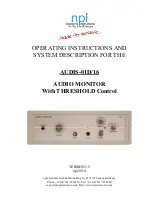
New Classic Edition 2.0
FASTTEL Klipsenstraat 18A 9160 Lokeren
Tel : + 32 (0) 9 244 65 20 FAX:+ 32 (0) 9 244 65 29 Email:
Web :
WWW.FASTTEL.BE
11
5. Setting of destinations
With the Wizard you can set 2 destinations per push button.
How ?
710 xxxxxxx
#
First number, first push button
711 xxxxxxx
#
Second number, first push button
Example : 710
0
056694010
#
for first push button (max. 13 digits)
710
= code for programmation first number,
0
= line access code if you are connected to a PABX central,
056694010
= destination,
#
= end sign,
*
= 2 second pause
Remark: if * is the first digit, then * will not be seen as a pause anymore
#
has to be entered after each destination number.
For the pushbuttons 2 to 3 you use:.
720-721
first and second destination 2
nd
pushbutton
730-731
first and second destination 3
rd
push button
ATTENTION
When using day/night mode,
even
codes Day,
uneven
codes Night
6. Conversation acceptance (from software version 1.7)
When a voicemail system answers the call the Wizard will see this as answering the call and so it will
not call the next number. The function ‘conversation acceptance’ offers the solution.
1*0
(default) no conversation acceptance
1*1
activate conversation acceptance
When this function is activated the person who answers the call has to compose * within the first 5
seconds. If done so, the conversations stays open. If no * was composed, the call will be ended and
the next number in the memory of the Wizard will be dialed.
The time before * is formed the speech path is not opened so both parties do not hear each other.
Code
522
must also be activated to activate this function.
7. setting number of ring tones
Setting “number of rings before next destination”
The Wizard calls the first number in his memory before chosing the second one.
How ?
New Classic Edition 2.0
FASTTEL Klipsenstraat 18A 9160 Lokeren
Tel : + 32 (0) 9 244 65 20 FAX:+ 32 (0) 9 244 65 29 Email:
Web :
WWW.FASTTEL.BE
12
Code
82XX
, with XX the number of rings before dialing next destination (default 8210 =
appr. 10 rings)
When a dialed number is occupied, this number can be repeated several times.
You can choose to switch this function on or off.
How ?
Code
6 60
no redial when occupied
(will call next set destination immediately)
Code
6 61
repeat when occupied
(on detection of occupation tone, the first destination will immediately be
repeated)
Adjusting number of redials
The Wizard will, when occupied, repeat the destination serveral times. After XX repeats, the
Wizard will dial a next destination.
How ?
Code
83XX
, XX = the number of occupations before dialing the next destination. Eg. 8305 = 5
occupations.
8. Wizard Classic with access keyboard
The optional keyboard incorporated in the Wizard Classic can be used as:
1.
access control keyboard: as stand alone (40 codes of 4 digits)(default) or Wiegand
2.
telephone keyboard (max. 20 characters)
Code 110: access control (default)
Code 111: telephone keypad
When the second option (telephone keyboard) is set, you can still enter an acces code provided *
<code> # is entered.
e.g.
when entering 11#, number 11 is dialed
*1234#: the contact is operated when the code = 1234#.
No more than 40 access codes can be entered in the door telephone. (stand alone modus)
For each code, comprising 4 digits, one can determine whether the contact in the door phone or one
of the external relays of the optional module FT4SW or FT8SW will be activated.
The entry of the code on the door phone’s keypad will be terminated by the user with the #.
The choice between activation of the internal relay (stand alone modus) or Wiegand output is done
by the following code:
9370 : internal relay (default )
937 1 : 6 bit wiegand ( rosslare format)
937 2 : 6 bit wiegand nibble (also for paxton)
937 3 : full Paxton keypad
937 4 : 4 keys binary , wiegand 26 bits




























